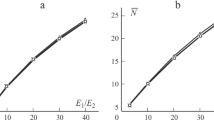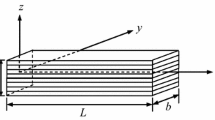Abstract
Thermo-mechanical buckling analysis of symmetric and antisymmetric laminated composite beams is performed based on a refined simple nth higher-order shear deformation theory. The theory accounts for the parabolic distribution of the transverse shear strains and satisfies the zero traction boundary conditions on the surfaces of the beam without using shear correction factors. The governing equations and corresponding simply boundary conditions are obtained with the aid of minimum total potential energy principle. The effects of temperatures on non-dimensional critical buckling loads are investigated. Numerical results due to present theory are compared with data available in the literature to show the accuracy and simplicity of the proposed theory in analyzing the thermo-mechanical buckling of laminated composite beams.

Similar content being viewed by others
References
Akbaş ŞD (2018) Post-buckling responses of a laminated composite beam. Steel Comput Struct 26(6):733–743
Akbas SD, Kocaturk T (2012) Post-buckling analysis of Timoshenko beams with temperature-dependent physical properties under uniform thermal loading. Struct Eng Mech 44(1):109–125
Akgöz B, Civalek O (2015) A microstructure-dependent sinusoidal plate model based on the strain gradient elasticity theory. Acta Mech 226(7):2277–2294
Aktaş M, Balcıoğlu EH (2014) Buckling behavior of pultruded composite beams with circular cutouts. Steel Comput Struct 17(4):359–370
Aydogdu M (2006) Buckling analysis of cross-ply laminated beams with general boundary conditions by Ritz method. Compos Sci Technol 66(10):1248–1255
Aydogdu M (2009) A new shear deformation theory for laminated composite plates. Compos Struct 89:94–101
Canales FG, Mantari JL (2016) Buckling and free vibration of laminated beams with arbitrary boundary conditions using a refined HSDT. Comput Part B 100:136–145
Della CN, Shu DW (2009) Free vibrations of delaminated beams in prebuckled states: lower and upper bounds. Struct Eng Mech 31(1):113–116
Dihaj A, Zidour M, Meradjah M, Rakrak K, Heireche H, Chemi A (2018) Free vibration analysis of chiral double-walled carbon nanotube embedded in an elastic medium using non-local elasticity theory and Euler Bernoulli beam model. Struct Eng Mech 65(3):335–342
Emam SA (2011) Analysis of shear-deformable composite beams in postbuckling. Compos Struct 94:24–30
Ergun E, Yilmaz Y, Çallioğlu H (2016) Free vibration and buckling analysis of the impacted hybrid composite beams. Struct Eng Mech 59(6):1055–1070
Feng J (2018) Compressive buckling analysis of orthotropic composite plates restrained by stringers. IOP Conf Ser J Phys Conf Ser. https://doi.org/10.1088/1742-6596/1074/1/012073
Huang X, Liu G, Liu Q, Bennison SJ (2014) The flexural performance of laminated glass beams under elevated temperature. Struct Eng Mech 52(3):603–612
Kahya V (2016) Buckling analysis of laminated composite and sandwich beams by the finite element method. Comput Part B. 91:126–134
Kapuria S, Dumir PC, Jain NK (2004) Assessment of zigzag theory for static loading, buckling, free and forced vibration of composite and sandwich beams. Compos Struct 64:317–327
Karama M, Afaq KS, Mistou S (2003) Mechanical behavior of laminated composite beam by new multi-layered laminated composite structure model with transverse shear stress continuity. Int J Solids Struct 40:1525–1546
Khdeir AA (2001) Thermal buckling of cross-ply laminated composite beams. Acta Mech 149:201–213
Khdeir AA, Reddy JN (1997) Buckling of cross-ply laminated beams with arbitrary boundary conditions. Compos Struct 37(1):1–3
Kim N-Il (2009) Series solutions for spatially coupled buckling analysis of thin-walled Timoshenko curved beam on elastic foundation. Struct Eng Mech 33(4):447–484
Kim N-Il, Choi D-H (2013) Super convergent laminated composite beam element for lateral stability analysis. Steel Comput Struct 15(2):175–202
Li Z-M, Qiao P (2015a) Buckling and postbuckling behavior of shear deformable anisotropic laminated beams with initial geometric imperfections subjected to axial compression. Eng Struct 85:277–292
Li Z-M, Qiao P (2015b) Thermal postbuckling analysis of anisotropic laminated beams with different boundary conditions resting on two-parameter elastic foundations. Eur J Mech A Solids 54:30–43
Li X, Yu K, Zhao R (2018) Thermal post-buckling and vibration analysis of a symmetric sandwich beam with clamped and simply supported boundary conditions. Arch Appl Mech 88(4):543–561
Mohri F, Damil N, Potier-Ferry M (2012) Pre-buckling deflection effects on stability of thin-walled beams with open sections. Steel Comput Struct 13(1):71–89
Reddy JN (1997) Mechanics of laminated composite plates. CRC Press, Boca Raton
Shen HS (2001) The effects of hygrothermal conditions on the postbuckling of shear deformable laminated cylindrical shells. J Solids Struct 38:6357–6380
Sobhy M, Zenkour AM (2018) Thermal buckling of double-layered graphene system in humid environment. Mater Res Exp 5(3):1–26
Soldatos KP (1992) A transverse shear deformation theory for homogeneous monoclinic plates. Acta Mech 94:195–200
Touratier M (1991) An efficient standard plate theory. Int J Eng Sci 29(8):901–916
Vo TP, Thai HT (2012a) Vibration and buckling of composite beams using refined shear deformation theory. Int J Mech Sci 62:67–76
Vo TP, Thai HT (2012b) Free vibration of axially loaded rectangular composite beams using refined shear deformation theory. Compos Struct 94(11):3379–3387
Xiang S (2014) A new shear deformation theory for free vibration of functionally graded beams. Appl Mech Mater 455:198–201
Xiaohui R, Wanji C (2009) Comparison of several displacement-based theories by predicting thermal response of laminated beam. Struct Eng Mech 33(6):781–784
Yu Y, Sun Y (2012) Analytical approximate solutions for large post-buckling response of a hygrothermal beam. Struct Eng Mech 43(2):211–223
Author information
Authors and Affiliations
Corresponding author
Appendix
Appendix
(1) Consider a laminate beam made of n plies. Each ply has a thickness of \(t_{k}^{{}}\). Then, the thickness of the laminate h is
Then, the location of the mid-plane is h/2 from the top or the bottom surface of the laminate. The z-coordinate of each ply k surface (top and bottom) is given by
Ply 1:
Ply k: \(\left( {k = 2,3, \ldots n - 2,n - 1} \right)\)
(2) Find the value of the reduced stiffness matrix \([Q]\) for each ply using its six elastic moduli, \(E_{1}^{{}} ,E_{2}^{{}} {\kern 1pt} {\kern 1pt} ,{\kern 1pt} {\kern 1pt} G_{12}^{{}} ,G_{13}^{{}} {\kern 1pt} {\kern 1pt} ,{\kern 1pt} {\kern 1pt} G_{23}^{{}} {\kern 1pt} {\kern 1pt} ,{\kern 1pt} \nu_{12}^{{}}\) in constants \(Q_{11} ,Q_{12} ,Q_{22} ,Q_{66} ,{\kern 1pt} Q_{44} {\kern 1pt}\) and \(Q_{55}\).
(3) Find the value of the transformed reduced stiffness matrix for each ply using the \([\bar{Q}]\) matrix calculated in step 2, and the angle of the ply and transformed coefficient of thermal expansion can be referred to any standard texts such as (Reddy (1997)).
(4) Knowing the thickness, \(t_{k}^{{}}\), of each ply, find the coordinate of the top and bottom surface, \(h_{i}^{{}} ,\quad i = 1 \ldots ,n,\) of each ply, using the following equation:
Ply n:
(5) Use the \([\bar{Q}]\) matrices from step 3 and the location of each ply from step 4 to find the six beam stiffness \((A_{11} ,{\kern 1pt} {\kern 1pt} B_{11} ,D_{11} ,B_{11}^{s} ,D_{11}^{s} ,H_{11}^{s}\) and \(A_{55}^{s}\)) from Eq. (7).
(6) Substitute the stiffness matrix values found in step 5 and the applied forces and moments in Eq. (6).
(7) Solve the three simultaneous Eqs. (14a–14c). Closed-form solutions are obtained using the Navier solution for simply supported laminated composite beams Eqs. (15a–15c), and the eigenvalue problem is solved to get the corresponding eigenvalues for buckling load equation with the effect temperature reduces the critical buckling load (18) and the critical temperature Eq. (19).
Rights and permissions
About this article
Cite this article
Derbale, A., Bouazza, M. & Benseddiq, N. Analysis of the Mechanical and Thermal Buckling of Laminated Beams by New Refined Shear Deformation Theory. Iran J Sci Technol Trans Civ Eng 45, 89–98 (2021). https://doi.org/10.1007/s40996-020-00417-6
Received:
Accepted:
Published:
Issue Date:
DOI: https://doi.org/10.1007/s40996-020-00417-6




